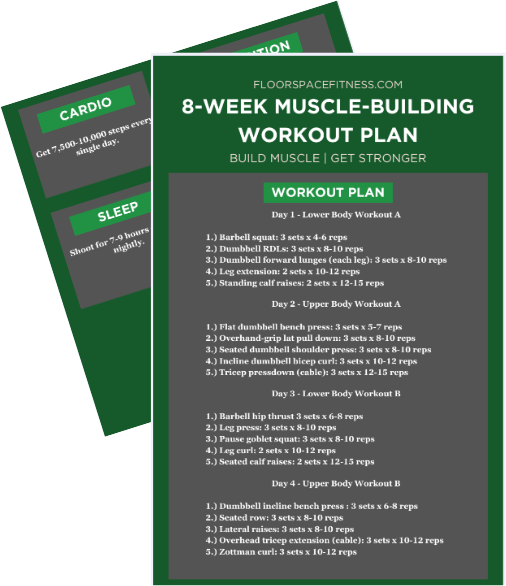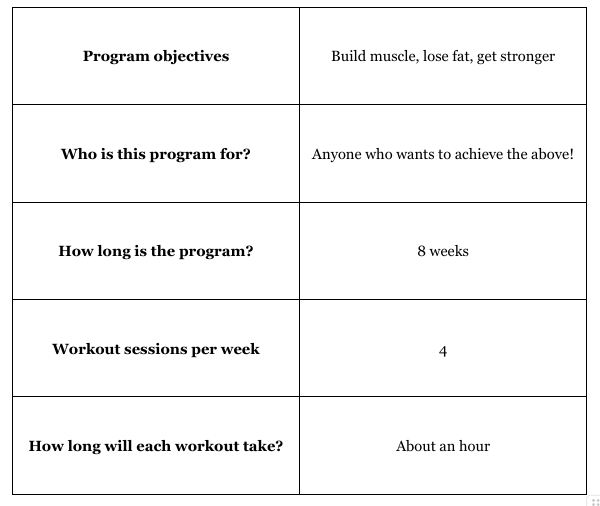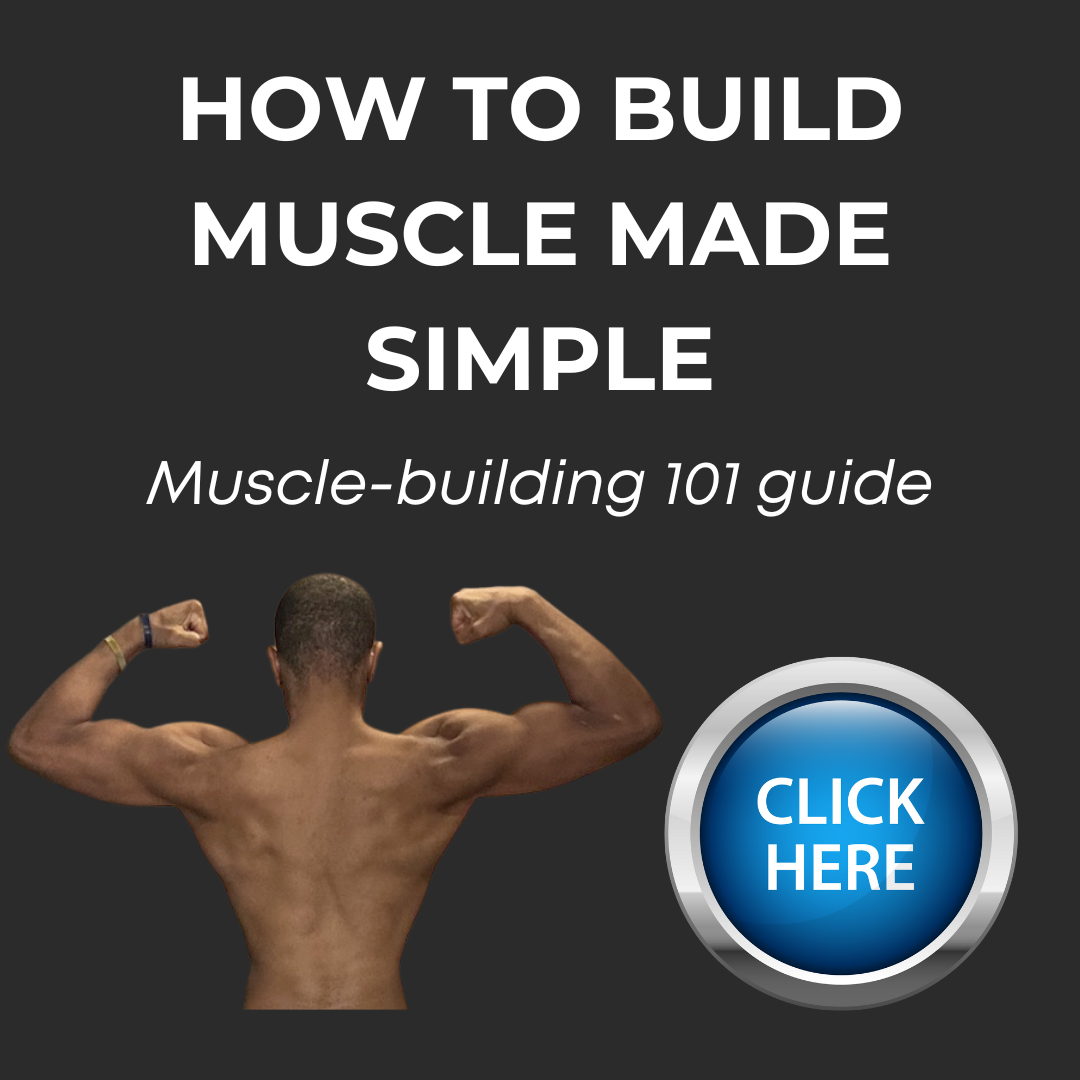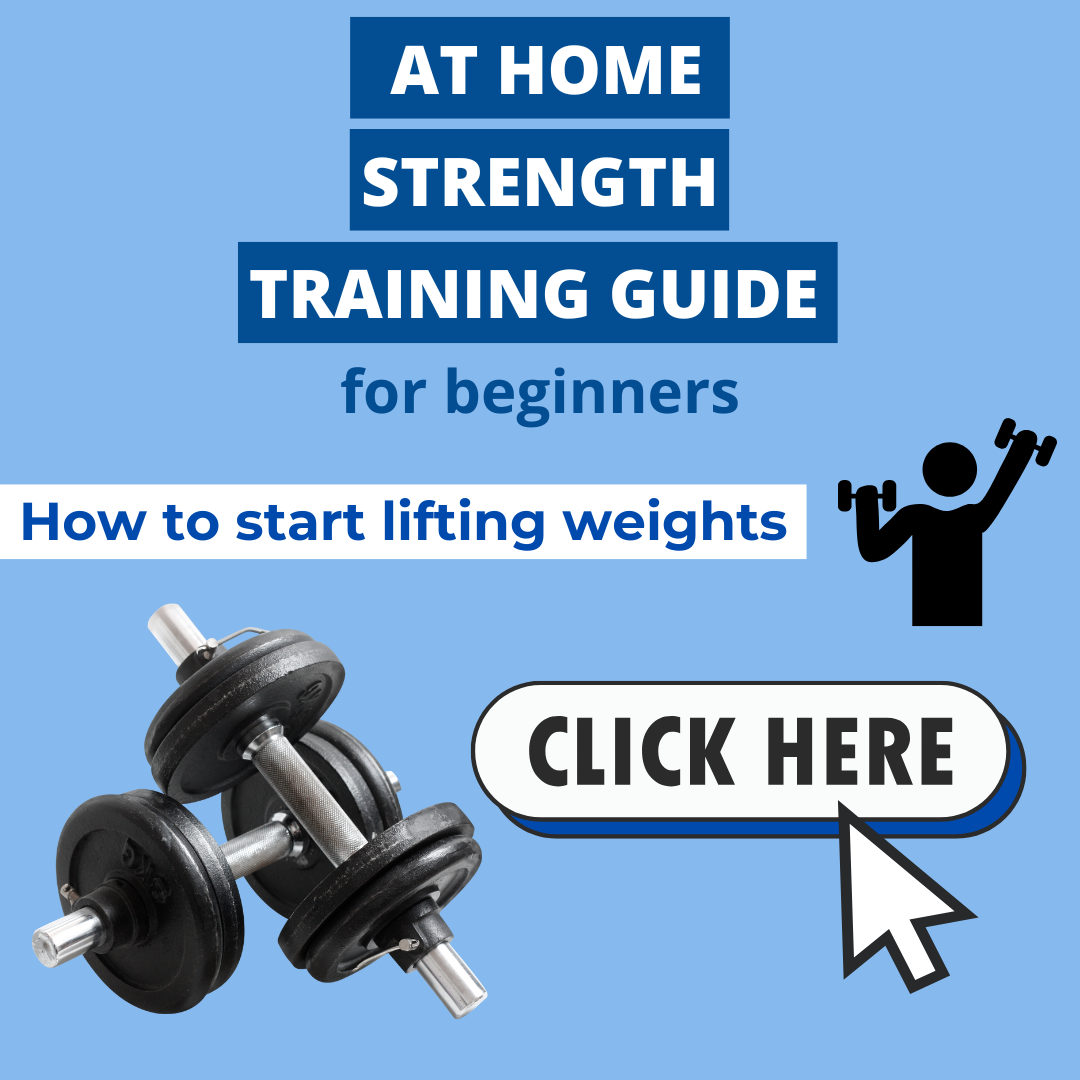
IN THIS POST
You need a strength training program (Random workouts won’t get the job done!).
Lucky for you, that’s what I’m here to provide you with today.
I’ve created a totally free 8-week muscle-building workout plan (with a printable PDF) for you to try.
This program works your entire body–from your chest, arms, and shoulders to your quads, hamstrings, glutes, and calves.
Not only will you receive a workout plan that has you covered for the next TWO MONTHS but I’ve also included my top workout and recovery tips, plus information on how to eat for muscle growth so you can make the most gains possible. 💪🏾

Program overview

Workout schedule
Your muscle-building workout plan is a 4-day upper/lower split.
This means you’ll have two lower body days and two upper body days each week (four total workouts).
The other three days of the week are rest days.
You don’t have to choose the same exact days but here’s an example workout schedule:
- Monday: Lower body workout A
- Tuesday: Upper body workout A
- Wednesday: Rest day
- Thursday: Lower body workout B
- Friday: Upper body workout B
- Saturday: Rest day
- Sunday: Rest day
Try as best as you can to workout on the same days each week.
Things will go a lot smoother if you stick to a consistent workout schedule.
By the way, each workout should take you around 45 min-1 hour to complete.
The muscle-building workout plan
Lower body workout A
- 1.) Barbell squat: 3 sets x 4-6 reps (tutorial)
- 2.) Dumbbell RDLs: 3 sets x 8-10 reps (tutorial)
- 3.) Dumbbell forward lunges (each leg): 3 sets x 8-10 reps (tutorial)
- 4.) Leg extension: 2 sets x 10-12 reps (tutorial)
- 5.) Standing calf raises: 2 sets x 12-15 reps (tutorial)
Upper body workout A
- 1.) Flat dumbbell bench press: 3 sets x 5-7 reps (tutorial)
- 2.) Overhand-grip lat pulldown: 3 sets x 8-10 reps (tutorial)
- 3.) Seated dumbbell shoulder press: 3 sets x 8-10 reps (tutorial)
- 4.) Incline dumbbell bicep curl: 2 sets x 10-12 reps (tutorial)
- 5.) Cable rope tricep press down: 2 sets x 12-15 reps (tutorial)
Lower body workout B
- 1.) Barbell hip thrust: 3 sets x 6-8 reps (tutorial)
- 2.) Leg press: 3 sets x 8-10 reps (tutorial)
- 3.) Pause goblet squat: 3 sets x 8-10 reps (tutorial)
- 4.) Leg curl: 2 sets x 10-12 reps (tutorial)
- 5.) Seated calf raises: 2 sets x 12-15 reps (tutorial)
Upper body workout B
- 1.) Dumbbell incline bench press: 3 sets x 6-8 reps (tutorial)
- 2.) Seated row: 3 sets x 8-10 reps (tutorial)
- 3.) Lateral raises: 3 sets x 8-10 reps (tutorial)
- 4.) Overhead tricep extension (cable): 2 sets x 10-12 reps (tutorial)
- 5.) Zottman curl: 2 sets x 10-12 reps (tutorial)
Rest time: This is just a guideline but least 2 minutes between sets (If you need more, take it!).
The most important strength training principle
Two words:
Progressive overload.
You apply progressive overload by gradually increasing the amount of weight you lift over time.
This places added stress on the body and your body adapts to the stress by building muscle.
Let’s say, for example, you start out bench pressing 100 lbs.
To apply progressive overload and see results you’d steadily make your way up to 105 lbs, 110 lbs, and so on.
If you’re a beginner, you’ll probably be able to make strength gains quickly and increase the weight workout to workout.
Buuuut the longer you strength train, the more you’ll see that strength gains are harder to come by.
You’ll eventually reach the point where a 5 lb increase on an exercise feels like a prayer answered. 😂
No matter whether you’re a beginner, intermediate, or advanced your mindset heading into your workouts should be, “I’m going to try to lift a little more weight than I did last time.”
Or, “I’m going to shoot for a few more reps than I did my last workout.”
Achieve greater gains with these 4 workout tips
If you want to build more muscle, lose more fat, and make greater gains, here are my top 4 strength training tips:
1. Emphasize the eccentric phase of your lifts
The eccentric phase = lowering the weight down.
For example, the eccentric phase of a squat would be lowering yourself down to the ground.
Or for bicep curls, it would be lowering the weight away from your body toward the ground.
Rather than go through your reps as quickly as possible, slow the eccentric phase down.
Take 3 seconds (or more if you’re up for a challenge) to lower the weight down.
You’ll place more tension on your muscle fibers, which leads to you getting more out of your workouts and achieving greater gains.
2. Actually take time to rest between sets
Don’t judge your workouts by how much you sweat.
Judge your workouts on how much weight you’re able to lift.
You’ll make the most progress and build the most muscle by lifting as heavy as you possibly can.
You can only do that if you’re taking adequate rest between sets.
Rest, at a MINIMUM, 2 minutes between sets on this program.
If more rest means lifting heavier weight, take more rest!
3. Keep workout intensity high
Your workouts shouldn’t feel like you’re going on a walk in the park with your dog.
That burn and strain you feel when it becomes a struggle to get the weight up?
Embrace that and push through it!
Challenging yourself is the only way you’ll see results.
On your sets, not all your reps should look the same.
The last 1-2 reps should be slower and take significantly more grit and effort.
4. Follow the program
Skipping around and choosing the exercises or workouts you like to do won’t produce the results you’re after.
The program is designed the way it is for a reason (to help you build the most muscle possible), so make sure you follow it!

The muscle-building golden rule
Building muscle comes down to being in a “calorie surplus.” (taking in more calories than you burn).
On the other hand, you need a calorie deficit for fat loss.
In most situations, you have to pick one goal and stick to it.
You either bulk (calorie surplus) to build muscle or cut (calorie deficit) to lose fat.
Isn’t there always an exception to the rule though?
Some people get the luxury of being able to build muscle and lose fat at the same time.
Wondering if you’re one of them?
This post will let you know!
How many calories to eat for muscle growth
You won’t build muscle by dieting and eating as few calories as possible.
You need to eat MORE calories than you burn.
I’ll show you how to calculate your muscle-building (surplus) calories in just two quick steps:
Step 1: Find your maintenance
This is the number of calories you’d eat to maintain your current weight.
Use this calculator to figure it out.
Just put in all your information and click calculate.
Step 2: Calculate your surplus calories
Once you have your maintenance, multiply it by 1.10 to get your surplus calories (You’ll eat this amount daily to build muscle).
For example, if your maintenance came out to 2,000 calories, your surplus would be 2,200 calories (2,000 x 1.10 = 2,200).
Make sure you’re consuming enough protein
What’s water to a plant?
Essential, right?
The same goes for protein when it comes to muscle growth.
It’s EXTREMELY important.
Your body undergoes a process known as muscle protein synthesis between workouts to repair your muscles and help them grow.
Having adequate protein intake is key to this process running smoothly, and ultimately, to you building the most muscle you possibly can.
How much protein are we talking here?
0.7g-1g per pound of your bodyweight in protein daily is the benchmark.
Related: 5 easy ways to eat more protein.
Should you do cardio when trying to build muscle?
Cardio isn’t necessary to build muscle.
BUT it’s beneficial for your overall health so you don’t want to eliminate it altogether.
No matter whether you’re trying to build muscle or lose fat, I’d recommend you simply get your daily steps (somewhere between 7,500 and 10,000).
Walking is easy to do and low-impact.
It won’t take energy away from your strength training sessions, which need to be the number one workout priority.
FYI, research shows walking significantly decreases your all-cause mortality risk (risk of dying from virtually anything).
Related: Hit your step goal every single day with these 15 simple strategies.
Workout recovery
You might think you build muscle during your workouts but muscle growth actually happens during recovery.
So, not recovering properly means sacrificing gains.
Let’s not make that a thing for you:
- Get 7-9 hours of sleep each night. Your body produces hormones key to muscle growth while you sleep. Plus, enough sleep means having more energy for your workouts. Performing better in the gym will lead to more progress.
- Have planned rest days (You have three on this program every single week so you’re covered here).
- As we’ve also talked about, consume 0.7g-1g per pound of bodyweight in protein daily to help repair and grow your muscles.
Related: How long does it take to build muscle?

What's up?
I’m Chad, I’m happy you’re here! I’m a certified personal trainer and my goal is to help you form practical, sustainable habits that lead to lifelong fitness results. If you want to lose fat, build muscle, and live a healthier, happier life then you’re right where you need to be. 💪🏾
Free resources
⬇⬇⬇










0 Comments